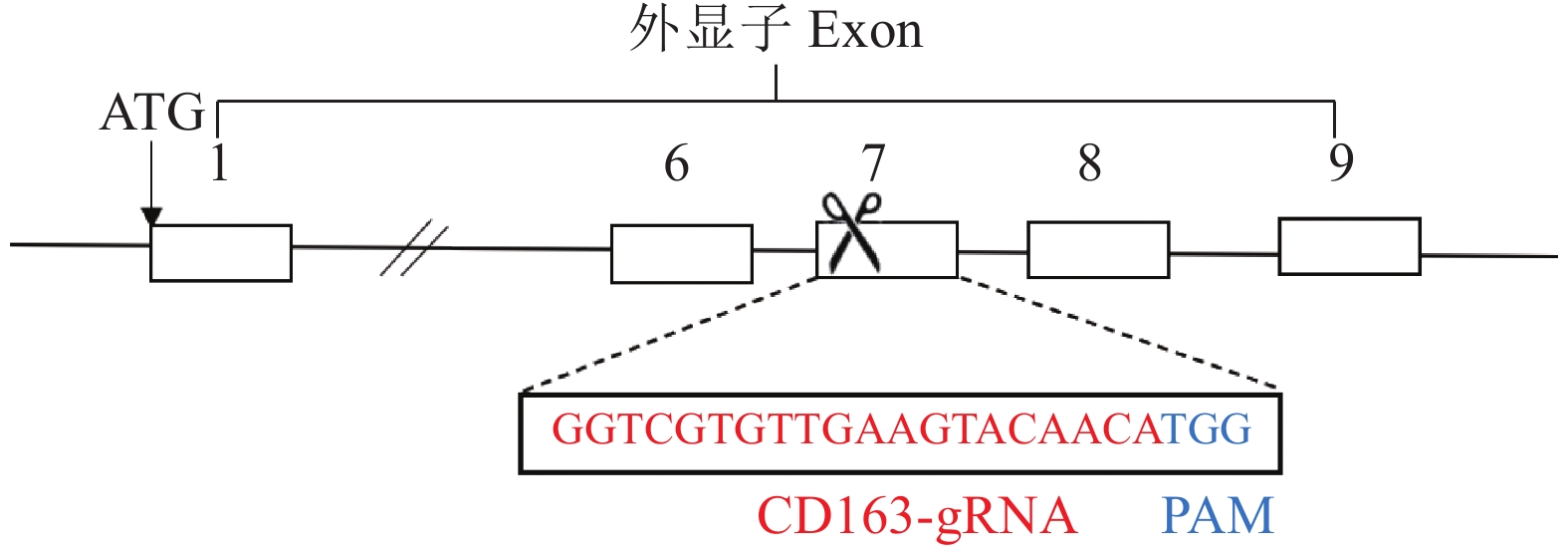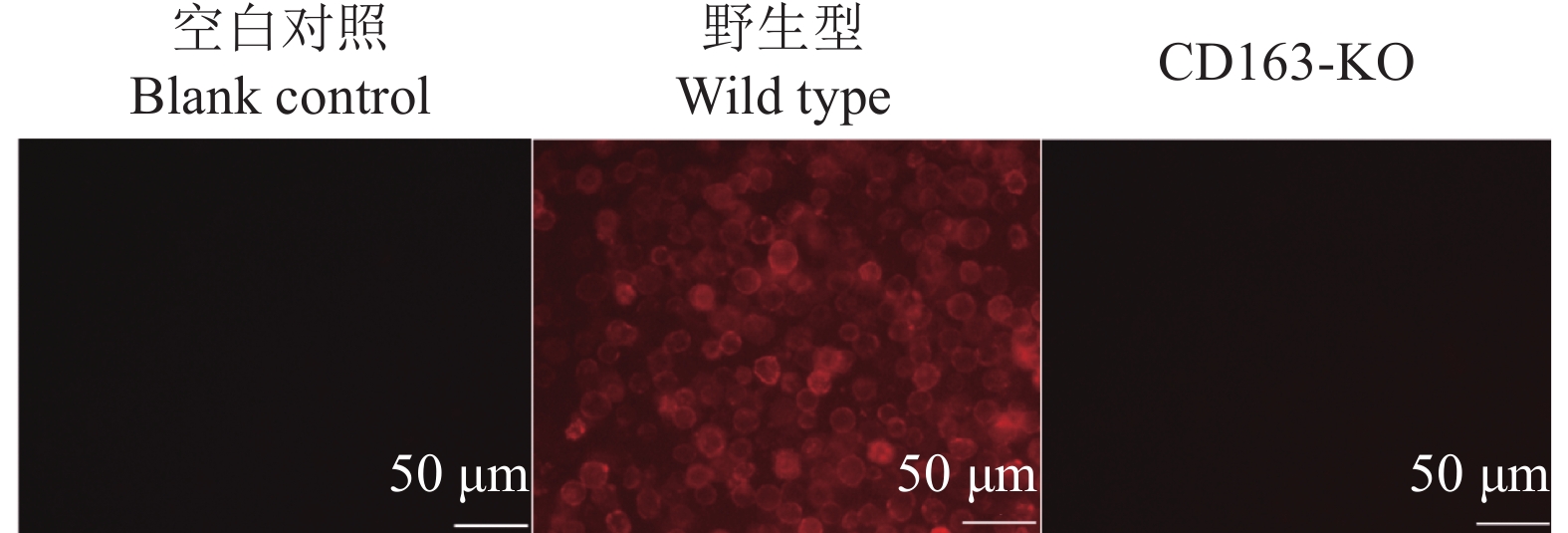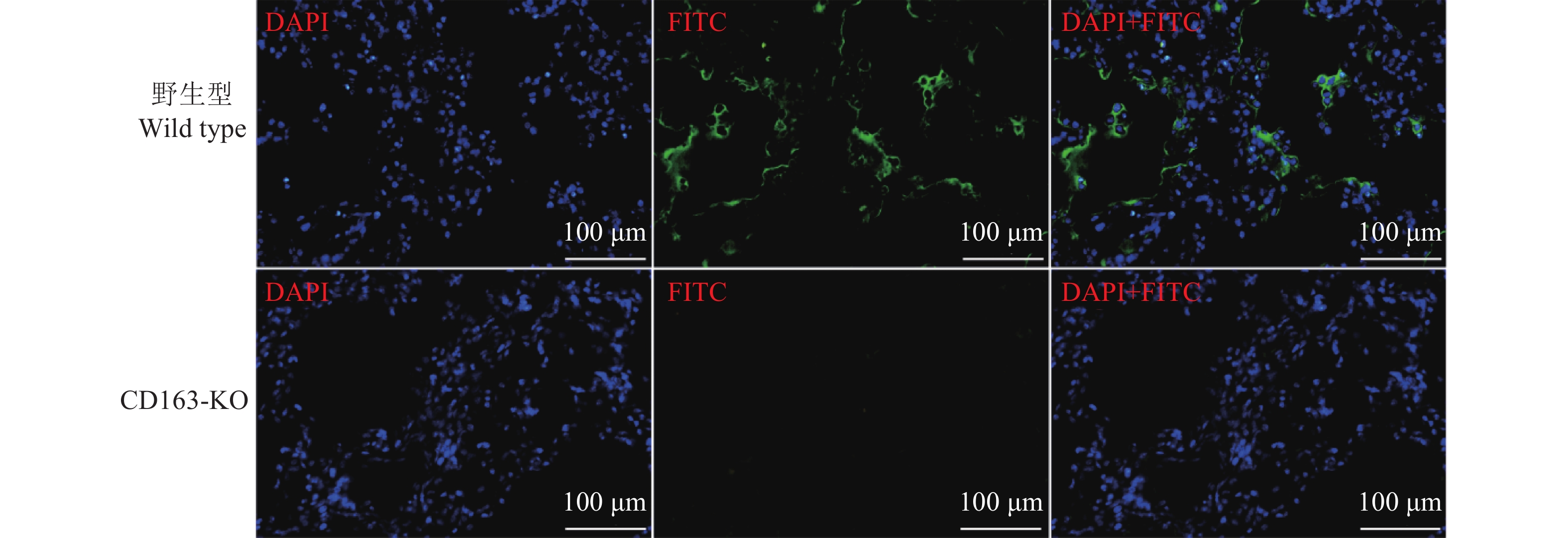Resistance to blue ear disease and production performance assessment of CD163 gene-edited Large White pigs
-
摘要:目的
运用CRISPR/Cas9基因编辑技术和体细胞核移植技术获得CD163基因全敲除(CD163 gene knockout,CD163-KO)的克隆猪,验证该基因敲除大白猪的抗蓝耳病特性,并研究其与野生型大白猪在生理、生产和繁殖性能等方面的差别,评估CD163-KO大白猪的主要生产性能。
方法用猪繁殖与呼吸综合征病毒(Porcine reproductive and respiratory syndrome virus,PRRSV)流行毒株NADC30-like对本研究所获得的11头CD163-KO大白猪和5头年龄、体质量相当的野生型大白猪进行攻毒试验。连续14 d观察猪的临床症状,记录直肠温度变化,检测血清中PRRSV病毒含量和抗体水平。14 d后取肺部组织进行切片,通过PRRSV免疫荧光试验观察肺脏感染情况。采集CD163-KO和野生型大白猪肺泡巨噬细胞进行免疫染色,观察肺泡巨噬细胞表面CD163蛋白的表达情况;采集猪外周血单核细胞进行诱导分化,观察CD163-KO与野生型大白猪诱导分化的巨噬细胞对血红蛋白−结合珠蛋白复合物的摄取情况。最后,统计分析CD163-KO与野生型大白猪的生产性能及公猪的繁殖性能。
结果本研究获得的CD163-KO大白猪对蓝耳病NADC30-like毒株具有完全抗性,敲除CD163基因不影响巨噬细胞的生理功能,CD163-KO与野生型大白猪的生长性能和繁殖性能无明显差异。
结论本研究是对CD163-KO猪抵抗蓝耳病的又一佐证和补充,证明CD163基因敲除操作对生产性能没有潜在的负面影响,为抗蓝耳病猪的生物安全提供了支撑。
Abstract:ObjectiveThe purpose of this study was to generate CD163 gene knockout (CD163-KO) Large White pigs by CRISPR/Cas9 gene editing and somatic cell nuclear transfer technologies, investigate the resistance to blue ear disease and the biosafety effect including physiology, productive and reproductive performances of the gene knockout pigs, and assess the main production performances of CD163-KO Large White pigs.
MethodIn this study, the 11 CD163-KO pigs and five age- and body weight-matched wild type Large White pigs were challenged with NADC30-like strain of porcine reproductive and respiratory syndrome virus (PRRSV). The rectal temperature, PRRSV antibody and virus variation were monitored continuously for 14 days. The lung tissues were examined by immunofluorescence of PRRSV antigen. Expression of CD163 protein on the surface of pulmonary alveolar macrophages in wild type and CD163-KO Large White pigs were examined through immunofluorescence staining. We compared the differentiation potential of monocytes into macrophages between CD163-KO and wild type pigs, and observed their uptake capacities to hemoglobin-haptoglobin complex. In addition, we analyzed the growth and reproductive production of the boars between CD163-KO pigs and wild type control to assess their biosafety and breeding value.
ResultCD163-KO pigs were completely resistant to NADC30-like strain without impairing the biological function associated with the modified gene, as well as productive and reproductive performances.
ConclusionThis study is an evidence and supplement of CD163-KO pigs resistance to blue ear disease, and demonstrates that CD163 gene knockout has no potentially negative effects on production performance, which provides evidences for the biosecurity of CD163-KO pigs.
-
近年来浓香型烤烟Nicotiana tabacum L.风格弱化和特色优质烟叶供应不足已成为我国烟草行业的一个重大问题,直接制约品牌卷烟上升水平。有研究表明烤烟品质受品种、栽培技术、烘烤工艺和生态条件等多种因素影响,其中生态条件对烤烟质量的贡献率高达56%[1],是特色烟叶形成的重要基础[2-3]。气候和土壤是影响烤烟质量与风格特征的两大生态因子,但目前仍不清楚二者是如何影响烟叶风格特征的[4]。蔡永占等[5]指出,在不同的生态试验点,丽江的气候条件更利于烟叶碳水化合物的积累。赵福杨等[6]报道在不同类型土壤条件下种植的烤烟,其化学成分存在显著差异,其中沙质土种植的烤烟,其化学成分较为协调。王海涛[7]指出,河南烟区不同日照、降水和温湿度条件对烟叶化学成分存在不同的影响。国内其他烟区也有关于生态条件对烤烟质量影响的研究报道,但将气候因子和土壤因子结合起来的研究报道较少,结果也不一致[8-10]。
南雄烟区是我国著名的浓香型优质烟叶产区之一,所产烟叶以浓香型、高香气的调香为主[11]。现有文献虽然对南雄烟区的生态条件进行了全面的评价[12],但并未指出气候和土壤因子影响烟叶品质及风格特征形成的作用机理,因此开展相关的研究迫在眉睫。本文根据2个不同生态亚区帽子峰与古市生态条件和地域的微观差异,在两地互相置换相同质地土壤,研究土壤和气候条件对不同生育时期烟叶光合特性参数和烤后烟叶化学成分的影响,探讨影响浓香型烤烟风格特征的关键生态因子,为浓香型特色优质烟叶开发提供参考和依据。
1. 材料与方法
1.1 试验材料
供试烤烟品种为‘粤烟97’,浓香型,由广东省烟草南雄科学研究所提供。
1.2 试验点生态条件
试验于2015—2016年连续2年在广东省南雄市帽子峰镇和古市镇同时进行,试验田块相对平坦,有代表性,排灌方便,前茬为水稻。供试土壤类型均为沙泥田,基本理化性质如表1所示。
表 1 土壤基本理化性质1)Table 1. The basic physicochemical property of soil试验点
Test sitepH w(H2O)
/%w/(g·kg–1) w/(mg·kg–1) 有机质
Organic matter全氮
Total N全钾
Total K全磷
Total P速效磷
Available P碱解氮
Alkaline N速效钾
Available K帽子峰 Maozifeng 5.08 23.05 24.75±0.35b 1.40±0.04a 169.58±2.94a 5.02±0.17b 27.00±0.40b 10.71±0.11b 44.25±1.67b 古市 Gushi 5.20 28.69 29.68±0.94a 1.50±0.01a 143.96±3.33b 6.13±0.15a 30.81±0.56a 14.08±0.17a 63.09±2.38a 1) 同列数据后不同小写字母表示差异显著 (P<0.05,t 检验)
1) Different lowercase letters in the same column indicated significant difference (P<0.05,t test)南雄属于中亚热带季风湿润气候,四季分明,年平均气温19.7 ℃,年降水量1 550 mm,年日照1 850 h,无霜期293 d[13]。2个试验点虽处于相同生态区,但地形和海拔有所差异,帽子峰山地环绕,海拔375 m,古市以平原为主,海拔121 m。2016年烤烟不同生育期的大田气象资料如表2所示,数据由广东省南雄市气象局提供。
表 2 2016年烤烟不同生育期的大田气象资料Table 2. Meteorological data during field growth period of tobacco in 2016时间(生育期)
Time (Growth period)试验点
Site降水量
/mm
Percipitation平均气温
/℃
Temperature日照时数
/h
Sunshine3 月 March 帽子峰 Maozifeng 86.20 13.20 90.80 古市 Gushi 312.90 15.00 90.80 4 月 April 帽子峰 Maozifeng 182.50 21.50 60.80 古市 Gushi 280.10 22.30 60.80 5 月 May 帽子峰 Maozifeng 172.20 23.20 122.90 古市 Gushi 168.40 24.60 122.90 6 月 June 帽子峰 Maozifeng 157.80 26.80 201.00 古市 Gushi 123.30 28.20 201.00 伸根期
Elongation stage帽子峰 Maozifeng 186.10 16.53 125.40 古市 Gushi 412.80 16.90 113.90 旺长期
Fast growing stage帽子峰 Maozifeng 154.50 22.13 50.10 古市 Gushi 180.20 22.15 37.70 成熟期
Maturity stage帽子峰 Maozifeng 258.10 25.45 300.00 古市 Gushi 291.70 26.42 323.90 大田生育期
Field growth stage帽子峰 Maozifeng 598.70 21.18 475.50 古市 Gushi 884.70 22.53 475.50 1.3 试验设计
采用随机区组设计,以土壤和气候为试验因素,采用置换土壤的方法,设置4个处理。T1:将帽子峰沙泥田土壤置换到古市,在古市气候条件下种植烤烟;T2:在古市沙泥田土壤和古市气候条件下种植烤烟;T3:将古市沙泥田土壤置换到帽子峰,在帽子峰气候条件下种植烤烟;T4:在帽子峰沙泥田土壤和帽子峰气候条件下种植烤烟。每个处理重复3次,共12个小区,每个小区种植烤烟30株,小区四周设保护行。土壤置换方法是分别在帽子峰和古市选择相同土壤质地的沙泥田,各试验小区按长5.0 m、宽4.0 m、深0.3 m的规格挖坑,将2个试验点各小区土壤各取30 cm深,耕作层与犁底层分层挖出,2层土壤同时互换,在分层依序回填之前先铺黑色地膜,地膜底部钻洞便于排水。试验烟苗分别于2015、2016年的2月20日移栽,田间管理统一按当地优质烟叶生产技术标准进行,烟叶采烤按照烟叶成熟标准和密集烘烤工艺[14]操作。由于2015—2016年连续2年试验结果相似,本文以2016年试验结果为例。
1.4 测定项目及方法
1.4.1 光合特性参数
采用LI-6400便携式光合测定系统(LI-COR,美国)分别在移栽后30、40、50、60和70 d的10:00—12:00选取中部叶测定叶片气孔导度、蒸腾速率、胞间CO2浓度和净光合速率,每个处理重复3次。
1.4.2 常规化学成分
每个处理分别选取烤后不同部位烟叶(上部叶、中部叶和下部叶)测定化学成分含量。烟碱含量采用分光光度法[15]测定;可溶性总糖和淀粉含量采用蒽酮比色法[16]测定;还原糖含量采用3,5−二硝基水杨酸(DNS)比色法[16]测定;钾含量采用火焰光度计法[16]测定;总氮含量采用凯氏自动定氮仪CID-310(Foss,瑞典)测定。
1.5 数据处理及分析
采用Excel 2013整理数据,Origin Pro 9.1制图,使用SPSS 21.0进行数据统计分析。土壤、气候及二者互作的贡献效果检验采用主效应分析法,同时引入偏Eta平方值Pη2解释分析结果,0.01<Pη2≤0.06表示低度影响效应,0.06<Pη2≤0.16表示中度影响效应,Pη2>0.16表示高度影响效应[17]。为保证数据独立性的要求,对相同处理不同部位烟叶化学指标取算数平均值后再进行双因素方差分析,以显著水平P=0.05为自变量取舍的临界值。
2. 结果与分析
2.1 不同生态亚区土壤和气候条件对烟叶光合特性的影响
从图1可以看出,不同生态亚区土壤和气候条件对烟叶光合特性参数有显著影响。各处理气孔导度均呈先缓升再陡降后缓降的趋势,在移栽50 d左右达到峰值,整体来看,T1处理气孔导度最大,其次为T2、T3,T4最小。蒸腾速率均呈先缓升后陡降的趋势,移栽50 d之前T2处理高于T1,移栽50 d之后T2下降速率高于T1,最终T2的蒸腾速率低于T1。胞间CO2浓度均呈先降低后升高的趋势,在移栽50 d时达最小值,整体来看,在移栽50 d之后T1、T2、T3和T4处理的胞间CO2浓度依次升高。净光合速率变化趋势与胞间CO2浓度完全相反,呈陡升–缓升–缓降–陡降的趋势,各处理变化趋势的走向趋于平行,在移栽50 d时达最大值,T1处理净光合速率为21.80 μmol·m–2·s–1,T2为21.03 μmol·m–2·s–1,T3为19.16 μmol·m–2·s–1,T4为18.82 μmol·m–2·s–1。T1与T2、T3与T4处于相同气候条件不同土壤条件,移栽50 d时,T1处理的净光合速率比T2高3.66%,T3比T4高1.81%;T1与T4、T2与T3处于相同土壤条件不同气候条件,移栽50 d时,T1处理的净光合速率比T4高15.83%,T3比T2低8.89%。
2.2 不同生态亚区土壤和气候条件及其互作对烟叶光合特性的主效应分析
将土壤和气候条件作为分组因素进行主效应分析,结果见表3。不同土壤条件下烟叶光合特性参数(气孔导度、蒸腾速率、胞间CO2浓度和净光合速率)均差异不显著(P≥0.177),对应的Pη2均小于0.06,表明土壤条件对烟叶光合特性参数影响很弱;不同气候条件下烟叶光合特性参数差异均达到极显著水平(P<0.01),对应的Pη2均大于0.16,表明气候条件对光合特性参数具有高度影响;在土壤与气候互作条件下只有气孔导度的差异达极显著水平(P=0.001),Pη2=0.237,蒸腾速率、胞间CO2浓度和净光合速率的差异未达显著水平(P>0.05),Pη2≤0.065,表明土壤与气候互作对气孔导度影响较强,对蒸腾速率、胞间CO2浓度和净光合速率影响较弱。综上所述,影响烟叶光合特性参数的主要因素是气候,其次是土壤与气候互作,土壤因素相对较弱。
表 3 不同生态亚区土壤与气候及其互作对烟叶光合特性的主效应分析Table 3. Analyses of main effects of soil, climate and their interaction on photosynthetic characteristics of tobacco leaves in different ecological subregions测定指标
Measured index变异来源
Variation source平方和
Sum of squares自由度
Degree of freedom均方
Mean squareF P Pη2 气孔导度 Stomatal conductance 土壤 Soil 0.003 1 0.003 1.881 0.177 0.041 气候 Climate 0.105 1 0.105 62.605 0.000 0.587 土壤×气候 Soil × climate 0.023 1 0.023 13.634 0.001 0.237 误差 Error 0.074 8 0.002 总变异 Total variations 8 773.109 11 蒸腾速率 Transpiration rate 土壤 Soil 0.416 1 0.416 0.559 0.459 0.013 气候 Climate 25.799 1 25.799 34.660 0.000 0.441 土壤×气候 Soil × climate 1.908 1 1.908 2.563 0.117 0.055 误差 Error 32.751 8 0.744 总变异 Total variations 60.874 11 胞间CO2浓度 CO2 concentration 土壤 Soil 11.408 1 11.408 0.078 0.781 0.002 气候 Climate 1 966.848 1 1 966.848 13.472 0.001 0.234 土壤×气候 Soil × climate 370.963 1 370.963 2.541 0.118 0.055 误差 Error 6 423.890 8 145.998 总变异 Total variations 8 773.109 11 净光合速率
Net photosynthetic rate土壤 Soil 0.480 1 0.480 0.075 0.785 0.002 气候 Climate 84.907 1 84.907 13.348 0.001 0.233 土壤×气候 Soil × climate 19.584 1 19.584 3.079 0.086 0.065 误差 Error 279.894 8 6.361 总变异 Total variations 384.865 11 2.3 不同生态亚区土壤和气候条件对烤后烟叶化学成分含量及协调性的影响
从表4可以看出,与T3、T4处理相比,T1、T2烤后烟叶的化学成分含量及其协调性更趋于浓香型优质烟叶的最适范围。在中部叶中,T1处理的总糖、还原糖和淀粉含量分别比T2低5.74%、4.77%和10.73%,差异均达到显著水平(P<0.05)。各处理的烟碱质量分数在1.83%~3.16%之间,其中T1处理上、中、下部叶的烟碱含量分别显著高于T2处理8.59%、6.49%、5.41%(P<0.05)。各处理K+质量分数在1.95%~2.81%范围内波动,T1处理中部叶的K+含量比T2高11.07%(P<0.05),上部叶和下部叶各处理间K+含量差异均不显著。各处理总氮质量分数在1.58%~2.47%之间,T1处理上部叶的总氮含量比T2低5.67%,中部叶的总氮含量比T2高11.34%,且差异显著(P<0.05)。各处理淀粉质量分数在3.65%~5.52%之间波动,除了T3、T4处理上部叶和T3处理中部叶的淀粉质量分数大于5%外,其他处理的淀粉质量分数均小于5%。各处理糖碱比和氮碱比分别在6.86~9.89和0.75~0.90范围内波动,均落在浓香型优质烟叶的最适范围,化学成分协调性较好。
表 4 不同生态亚区土壤和气候条件对烤后烟叶化学成分含量及其协调性的影响1)Table 4. Effects of soil and climate on chemical constituent contents and coordinations of flue-cured tobacco leaves in different ecological subregions烟叶
Tobacco leaf处理
Treatmentw/% 糖碱比
Ratio of sugar to nicotine氮碱比
Ratio of N
to nicotine总糖
Total
sugar还原糖
Reducing
sugar烟碱
NicotineK+ 总氮
Total N淀粉
Starch上部叶 Upper leaf T1 21.70±0.35a 17.81±0.18a 3.16±0.03a 2.37±0.12a 2.33±0.02b 4.46±0.17b 7.46±0.10a 0.80±0.01b T2 21.69±0.61a 16.92±0.11a 2.91±0.04b 2.29±0.16a 2.47±0.02a 4.94±0.23ab 6.86±0.13b 0.78±0.00b T3 19.04±0.15b 14.12±0.31b 2.66±0.01c 2.17±0.13a 1.99±0.01d 5.29±0.27a 7.15±0.09ab 0.75±0.01b T4 19.34±0.41b 14.55±0.04b 2.63±0.01c 2.04±0.04a 2.24±0.01c 5.52±0.20a 7.35±0.18a 0.85±0.01a 中部叶 Middle leaf T1 21.03±0.11b 17.75±0.11b 2.46±0.02a 2.81±0.06a 2.16±0.01a 3.66±0.05d 8.55±0.04b 0.88±0.01a T2 22.31±0.17a 18.64±0.05a 2.31±0.02b 2.53±0.08b 1.94±0.12b 4.10±0.05c 9.67±0.11a 0.84±0.05a T3 19.11±0.33c 15.44±0.44c 2.05±0.01c 2.39±0.07b 1.85±0.01b 5.29±0.20a 9.32±0.19a 0.90±0.01a T4 19.68±0.24c 17.16±0.20b 2.36±0.04b 2.32±0.05b 2.01±0.01ab 4.84±0.03b 8.33±0.21b 0.85±0.02a 下部叶 Lower leaf T1 21.03±0.07a 17.05±0.04a 2.34±0.02a 2.27±0.18a 1.79±0.13a 4.69±0.03ab 8.98±0.05b 0.76±0.05b T2 20.84±0.46a 16.40±0.06b 2.22±0.04b 1.95±0.15a 1.91±0.15a 4.86±0.03a 9.37±0.08a 0.86±0.07a T3 18.12±0.03b 15.35±0.29c 1.83±0.00d 2.24±0.06a 1.58±0.01a 3.65±0.20c 9.89±0.03a 0.86±0.01a T4 17.89±0.21b 13.47±0.08d 1.97±0.00c 2.14±0.10a 1.72±0.01a 4.33±0.22b 9.08±0.12b 0.88±0.00a 1) 相同部位烟叶的同列数据后,不同小写字母表示差异显著 (P<0.05,Duncan’s 法)
1) Different lowercase letters in the same column of the same tobacco leaf indicated significicant difference (P<0.05, Duncan’s method)2.4 不同生态亚区土壤和气候条件及其互作对烤后烟叶化学成分含量的主效应分析
将土壤与气候条件作为分组因素进行主效应分析,结果如表5所示。在不同土壤条件下烤后烟叶K+和总氮含量以及糖碱比差异显著(P<0.05),Pη2均大于0.16,表明土壤对K+和总氮含量及糖碱比具有显著影响;其他指标均差异不显著(P>0.05),其中总糖的Pη2小于0.06,其余在0.06~0.16之间,表明土壤对总糖含量影响较小,对其他指标有一定影响。在不同气候条件下K+含量和糖碱比差异不显著(P>0.05),其他指标的差异均达到显著水平(P<0.05),从Pη2来看,气候对糖碱比影响较小,对K+含量有一定影响,对其他指标有显著影响。在土壤与气候互作条件下除总糖和K+含量以及糖碱比差异不显著(P>0.05)外,其他指标的差异均达到显著水平(P<0.05),根据Pη2来看,土壤与气候互作对还原糖、烟碱、总氮和淀粉含量及氮碱比有显著影响,对总糖和K+含量及糖碱比有一定影响。
表 5 不同生态亚区土壤与气候条件及其互作对烤后烟叶化学成分含量及其协调性的主效应分析Table 5. Analyses of main effects of soil, climate and their interaction on chemical constituent contents and coordinations of flue-cured tobacco leaves in different ecological subregions测定指标
Measured index变异来源
Variation source平方和
Sum of squares自由度
Degree of freedom均方
Mean squareF P Pη2 总糖
Total sugar土壤 Soil 0.062 1 0.062 0.121 0.737 0.015 气候 Climate 5.286 1 5.286 10.237 0.013 0.561 土壤×气候 Soil×climate 0.602 1 0.602 1.166 0.312 0.127 误差 Error 4.131 8 0.516 总变异 Total variations 10.082 11 还原糖 Reducing sugar 土壤 Soil 0.463 1 0.463 1.098 0.325 0.121 气候 Climate 6.357 1 6.357 15.063 0.005 0.653 土壤×气候 Soil×climate 3.485 1 3.485 5.592 0.046 0.411 误差 Error 3.376 8 0.422 总变异 Total variations 13.681 11 烟碱 Nicotine 土壤 Soil 0.103 1 0.103 0.997 0.347 0.111 气候 Climate 1.334 1 1.334 12.951 0.007 0.618 土壤×气候 Soil×climate 0.659 1 0.659 5.394 0.049 0.403 误差 Error 0.824 8 0.103 总变异 Total variations 2.919 11 K+ 土壤 Soil 1.919 1 1.919 7.379 0.026 0.480 气候 Climate 0.332 1 0.332 1.275 0.291 0.138 土壤×气候 Soil×climate 0.254 1 0.254 0.978 0.352 0.109 误差 Error 2.081 8 0.260 总变异 Total variations 4.587 11 总氮 Total N 土壤 Soil 0.022 1 0.022 11.691 0.009 0.594 气候 Climate 0.120 1 0.120 62.925 0.000 0.887 土壤×气候 Soil×climate 0.029 1 0.029 6.165 0.038 0.435 误差 Error 0.015 8 0.002 总变异 Total variations 0.186 11 续表5 Continued table 5 测定指标
Measured index变异来源
Variation source平方和
Sum of squares自由度
Degree of freedom均方
Mean squareF P Pη2 淀粉 Starch 土壤 Soil 0.032 1 0.032 0.999 0.347 0.111 气候 Climate 0.410 1 0.410 12.951 0.007 0.618 土壤×气候 Soil×climate 0.184 1 0.184 5.821 0.042 0.421 误差 Error 0.253 8 0.032 总变异 Total variations 0.897 11 糖碱比
Ratio of sugar to nicotine土壤 Soil 0.195 1 0.195 15.298 0.005 0.657 气候 Climate 0.005 1 0.005 0.414 0.538 0.049 土壤×气候 Soil×climate 0.015 1 0.015 1.178 0.309 0.128 误差 Error 0.102 8 0.013 总变异 Total variations 0.317 11 氮碱比
Ratio of N to nicotine土壤 Soil 0.015 1 0.015 1.125 0.320 0.123 气候 Climate 0.098 1 0.098 7.312 0.027 0.478 土壤×气候 Soil×climate 0.197 1 0.197 12.729 0.007 0.614 误差 Error 0.107 8 0.013 总变异 Total variations 0.417 11 2.5 不同生态亚区气候因子与烤后烟叶化学成分含量及协调性间的相关性分析
将烤烟各生育期气候因子与烤后烟叶化学成分含量进行相关性分析,结果如表6所示。总糖含量与旺长期平均气温呈极显著负相关,还原糖含量与伸根期和旺长期降水量呈显著负相关,烟碱含量与伸根期降水量呈显著正相关,总氮含量与伸根期平均气温呈显著负相关,糖碱比与旺长期平均气温呈显著正相关,氮碱比与伸根期降水量呈显著正相关。上述相关性分析结果表明,影响烤后烟叶化学成分含量及协调性的主要气候因子是伸根期与旺长期的降水量和平均气温。
表 6 不同生态亚区气候因子与烤后烟叶化学成分含量的相关性分析1)Table 6. Correlation analyses between climate factors and chemical constituent contents of flue-cured tobacco leaves in different ecological subregions指标
Index伸根期 Elongation stage 旺长期 Fast growing stage 成熟期 Maturity stage 降水量
Precipitation平均气温
Mean temperature日照时数
Sunshine hour降水量
Precipitation平均气温
Mean temperature日照时数
Sunshine hour降水量
Precipitation平均气温
Mean temperature日照时数
Sunshine hour总糖
Total sugar−0.643 −0.533 −0.027 −0.527 −0.932** −0.085 −0.290 −0.240 0.074 还原糖
Reducing sugar−0.834* −0.704 −0.177 −0.628* −0.759 −0.157 −0.079 −0.053 0.315 烟碱
Nicotine0.798* 0.060 0.265 0.448 0.422 0.074 0.493 −0.106 −0.096 K+ 0.085 −0.037 −0.163 −0.093 −0.452 −0.156 0.534 −0.581 0.272 总氮
Total N−0.427 −0.791* 0.078 −0.493 −0.574 −0.123 0.569 −0.049 0.052 淀粉
Starch0.010 0.243 0.048 0.540 −0.156 −0.053 0.136 0.194 −0.019 糖碱比
Sugar/nicotine0.212 −0.301 −0.303 0.245 0.852* −0.089 −0.529 0.053 0.183 氮碱比
N/nicotine0.827* −0.257 −0.467 0.178 −0.009 −0.393 −0.061 0.182 0.382 1) “*” 和 “**” 分别表示 0.05 和 0.01 的显著相关
1) “*” and “**” indicated significant correlation at P<0.05 andP<0.01 levels, respectively3. 讨论与结论
光合作用是物质同化作用的主要过程,是植物生理代谢过程中重要有机物质的来源,净光合速率是衡量植物光合作用强弱的重要指标[18]。金云峰等[19]在烟草不同生育期叶片光合作用的研究中发现,移栽后至团棵期,烟叶的净光合速率逐渐升高,团棵期至现蕾期,净光合速率趋于平稳,成熟期急剧下降。柯学等[20-21]提出烟叶净光合速率变化曲线呈“抛物线”型。本研究发现,浓香型烟区大田生育期烤烟叶片的净光合速率呈“陡升–缓升–缓降–陡降”的趋势,这与前人[19-21]有关研究结果相似。有研究指出种植措施、光照、品种、肥料和温度等因素都会影响植物光合作用的强弱[22-23],将气候和土壤结合起来研究其对光合作用影响的报道比较少见。本研究发现影响烤烟光合特性的主要生态因子是气候,将帽子峰土壤置换到古市(T1处理)后种植的烟叶的净光合速率比在帽子峰当地土壤和气候条件(T4处理)下种植的烟叶高15.83%,将古市土壤置换到帽子峰(T3处理)后种植的烟叶的净光合速率比在古市当地土壤和气候条件(T2处理)下种植的烟叶低8.89%,即在相同土壤和不同气候条件下,古市生态亚区烟叶的净光合速率高于帽子峰烟叶,说明古市的气候条件可能更适合浓香型优质烟叶的生产。与帽子峰相比,移栽期古市降水丰富,月平均气温略高1~2 ℃,大田生育期日照时数接近500 h,成熟期在300 h以上,气候条件的微观差异可能是古市烟叶光合特性优于帽子峰烟叶的主要原因。将帽子峰沙泥田土壤置换到古市种植烟草,能够提高烟草光合作用水平,为后期有机物的积累奠定基础。
化学成分是影响烟叶内在品质的物质基础。一般认为,浓香型优质烟叶化学成分含量的适宜范围是总糖质量分数16%~23%,还原糖质量分数14%~18%,淀粉质量分数≤5%,总氮质量分数1.5%~2.3%,烟碱质量分数1.5%~3.5%,K+质量分数≥2.0%,糖碱比6~10,氮碱比<1[4, 24]。本研究2个试验点烤后烟叶的化学成分含量及其协调性接近浓香型优质烟叶范围,在古市种植的烟叶化学品质特征优于在帽子峰种植的烟叶。王行等[25]指出南雄产区烟叶浓香型风格特征弱化主要表现为中部叶含糖量大幅提升,烟碱含量下降。本研究发现,对中部叶来说,将帽子峰沙泥田土壤置换到古市(T1处理)后种植的烟叶与古市当地(T2处理)种植的烟叶相比,总糖和还原糖含量分别降低了5.74%和4.77%,烟碱含量提高了6.49%,达到了降糖升碱的效果,符合低糖、中烟碱的优质浓香型烟叶质量特征。因此,将帽子峰沙泥田土壤置换到古市种植烟叶能够改善烟叶化学成分及协调性,彰显浓香型风格特征。
国内外研究发现,土壤、气候及耕作条件对烟叶化学品质特征有显著影响[26-27],本研究在耕作条件一致的前提下发现,气候对总糖、还原糖、淀粉、烟碱和总氮含量及氮碱比有高度影响;土壤与气候互作对还原糖、淀粉、烟碱和总氮含量及氮碱比有高度影响,对总糖和K+含量及糖碱比有中度影响;土壤仅对K+和总氮含量及糖碱比有高度影响。这与黄爱缨等[26]和彭新辉等[28]研究结果相近。综上所述,影响烟叶化学品质的主要生态因子是气候条件,其次是土壤与气候互作。本研究将气候因子与烤后烟叶化学成分含量及协调性进行相关性分析发现,影响烟叶内在化学品质的主要气候因子是伸根期与旺长期的降水量和平均气温,这与王育军等[29]和李琦等[30]的研究结果有相似之处。
蔡雪娇等[31]和母少东等[32]在对相同生态区域烤烟品质的研究中指出,土壤对烟叶浓香型风格特征的形成有显著影响。本研究发现,气候是影响烤后烟叶品质及浓香型风格特征的主要因子,土壤的作用相对较弱。上述文献[31-32]的试验点均选在相同海拔和气候条件下,本研究的2个试验点只在相同生态区域,海拔不同,气候条件也存在微观差异,通过主效应分析和相关性分析得出,影响烤烟品质的主要生态因素是气候因子,尤其是伸根期与旺长期的降水量和平均气温。古市生态亚区降水呈“前中期多、后期少”的特点,这种独特的降水分布正是影响烟叶品质的重要因素。南雄烟区烟苗移栽时间一般在2月底3月初,降水充足,土壤底墒高,有利于烟苗成活。成熟后期(6月)降水适量减少,烟叶能够正常成熟落黄,有利于干物质及油分的积累。
本研究根据不同生态亚区土壤与气候条件的微观差异展开对烤烟品质及浓香型风格特征形成的探讨,运用主效应分析、Pη2和相关性分析等科学统计方法解释分析结果,得出了相关结论。本试验仅选取了降水量、平均气温和日照时数这3个代表性指标作为气候因子,后续研究中还需考虑相对湿度、蒸发量和海拔等因子的影响。总之构建浓香型特色烟叶生产技术体系时要综合考虑气候、土壤和地理等多方面因素的影响。
-
表 1 阳性单克隆细胞及CD163-KO大白猪测序结果
Table 1 Sequencing results of positive monoclonal cells and CD163-KO Large White pigs
类型 Type 靶位点序列(5′→3′) Sequence of target site 插入/缺失 Insertion/ Deletion 数量 Number 野生型大白猪 Wild type Large White pig GGTCGTGTTGAAGTACAACATGG 阳性单克隆细胞 Positive monoclonal cell GGTCGTGTTGAAGTACAAACATGG +A 3 CD163-KO大白猪 CD163-KO Large White pig GGTCGTGTTGAAGTACAAACATGG +A 18 表 2 野生型(n=10)和CD16-KO (n=5)大白猪生产性能比较1)
Table 2 Comparison of the productive performance of wild type and CD163-KO Large White pigs
项目 Item 野生型 Wild type CD163-KO P 出生体质量/kg Birth body weight 2.04±0.13 1.80±0.15 0.277 115 kg体长/cm Body length of 115 kg 119.8±1.2 119.2±1.0 0.746 115 kg体高/cm Body height of 115 kg 68.6±0.6 68.4±0.8 0.841 115 kg背膘厚/mm Backfat thickness of 115 kg 12.069±0.401 11.702±0.495 0.592 115 kg眼肌面积/cm2Eye muscle area of 115 kg 35.670±1.202 36.320±1.090 0.736 30 ~115 kg平均日增体质量/kg Average daily gain of body weight during 30−115 kg 1.075±0.047 1.008±0.068 0.428 30~115 kg饲料转化率 Feed/gain ratio during 30−115 kg 2.326±0.085 2.548±0.154 0.191 1)表中数据为平均值±标准误,P>0.05表示两组间差异不显著 (t检验) 1) Data are expressed as the mean ± standard error, P > 0.05 means there is no significant difference between two sets ( t test) 表 3 野生型(n=20)与CD163-KO (n=10)大白猪精液质量比较1)
Table 3 Comparison of the quality of the semen from wild type and CD163-KO Large White pigs
项目 Item 野生型 Wild type CD163-KO P 精子总数/亿 Number of sperms 680.643 ± 84.535 685.726 ± 99.930 0.971 1∶1稀释后精子活力 Sperm motility after 1∶1 dilution 0.675 ± 0.013 0.700 ± 0.000 0.219 1∶1稀释后精子密度/(亿·mL−1) Sperm density after 1∶1 dilution 1.685 ± 0.195 1.578 ± 0.239 0.747 精子畸形率/% Abnormal rate of sperm 11.092 ± 1.358 10.000 ± 0.964 0.606 1)表中数据为平均值±标准误,P>0.05表示两组间没有显著差异(t检验) 1) Data are expressed as the mean ± standard error, P > 0.05 means there is no significant difference between two sets ( ttest) -
[1] HAN J, ZHOU L, GE X, et al. Pathogenesis and control of the Chinese highly pathogenic porcine reproductive and respiratory syndrome virus[J]. Veterinary Microbiology, 2017, 209: 30-47. doi: 10.1016/j.vetmic.2017.02.020
[2] TIAN K, YU X, ZHAO T, et al. Emergence of fatal PRRSV variants: Unparalleled outbreaks of atypical PRRS in China and molecular dissection of the unique hallmark[J]. PLoS One, 2007, 2(6): e526. doi: 10.1371/journal.pone.0000526
[3] ZHAO K, YE C, CHANG X, et al. Importation and recombination are responsible for the latest emergence of highly pathogenic porcine reproductive and respiratory syndrome virus in China[J]. Journal of Virology, 2015, 89(20): 10712-10716. doi: 10.1128/JVI.01446-15
[4] WANG H M, LIU Y G, TANG Y D, et al. A natural recombinant PRRSV between HP-PRRSV JXA1-like and NADC30-like strains[J]. Transboundary and Emerging Diseases, 2018, 65(4): 1078-1086. doi: 10.1111/tbed.12852
[5] YU Y, ZHANG Q, CAO Z, et al. Recent advances in porcine reproductive and respiratory syndrome virus NADC30-like research in China: Molecular characterization, pathogenicity, and control[J]. Frontiers in Microbiology, 2022, 12: 791313. doi: 10.3389/fmicb.2021.791313.
[6] ZHOU L, YANG B, XU L, et al. Efficacy evaluation of three modified-live virus vaccines against a strain of porcine reproductive and respiratory syndrome virus NADC30-like[J]. Veterinary Microbiology, 2017, 207: 108-116. doi: 10.1016/j.vetmic.2017.05.031
[7] CHAI W, LIU Z, SUN Z, et al. Efficacy of two porcine reproductive and respiratory syndrome (PRRS) modified-live virus (MLV) vaccines against heterologous NADC30-like PRRS virus challenge[J]. Veterinary Microbiology, 2020, 248: 108805. doi: 10.1016/j.vetmic.2020.108805.
[8] RENUKARADHYA G J, MENG X J, CALVERT J G, et al. Inactivated and subunit vaccines against porcine reproductive and respiratory syndrome: Current status and future direction[J]. Vaccine, 2015, 33(27): 3065-3072. doi: 10.1016/j.vaccine.2015.04.102
[9] 熊胜利, 龙清孟, 陈大方, 等. 抗病育种技术在引进美国SPF种猪后代选育中应用探究[J]. 养猪, 2014(3): 73-74. doi: 10.13257/j.cnki.21-1104/s.2014.03.028 [10] YUAN H, YANG L, ZHANG Y, et al. Current status of genetically modified pigs that are resistant to virus infection[J]. Viruses, 2022, 14(2): 417. doi: 10.3390/v14020417.
[11] PROUDFOOT C, LILLICO S, TAIT-BURKARD C. Genome editing for disease resistance in pigs and chickens[J]. Animal Frontiers, 2019, 9(3): 6-12. doi: 10.1093/af/vfz013
[12] WHITWORTH K M, ROWLAND R R R, EWEN C L, et al. Gene-edited pigs are protected from porcine reproductive and respiratory syndrome virus[J]. Nature Biotechnology, 2016, 34(1): 20-22. doi: 10.1038/nbt.3434
[13] YANG H, ZHANG J, ZHANG X, et al. CD163 knockout pigs are fully resistant to highly pathogenic porcine reproductive and respiratory syndrome virus[J]. Antiviral Research, 2018, 151: 63-70.
[14] BURKARD C, LILLICO S G, REID E, et al. Precision engineering for PRRSV resistance in pigs: Macrophages from genome edited pigs lacking CD163 SRCR5 domain are fully resistant to both PRRSV genotypes while maintaining biological function[J]. PLOS Pathogens, 2017, 13(2): e1006206. doi: 10.1371/journal.ppat.1006206
[15] WELCH S K W, CALVERT J G. A brief review of CD163 and its role in PRRSV infection[J]. Virus Research, 2010, 154(1/2): 98-103. doi: 10.1016/j.virusres.2010.07.018
[16] XU Y, WU S, LI Y, et al. A porcine alveolar macrophage cell line stably expressing CD163 demonstrates virus replication and cytokine secretion characteristics similar to primary alveolar macrophages following PRRSV infection[J]. Veterinary Microbiology, 2020, 244: 108690. doi: 10.1016/j.vetmic.2020.108690.
[17] XU K, ZHOU Y, MU Y, et al. CD163 and pAPN double-knockout pigs are resistant to PRRSV and TGEV and exhibit decreased susceptibility to PDCoV while maintaining normal production performance[J]. eLife, 2020, 9: e57132.
[18] 韩晓松, 高杨, 刘海龙, 等. 利用CRISPR/Cas9技术制备CD163基因SRCR5序列敲除猪[J]. 农业生物技术学报, 2020, 28(9): 1535-1542. [19] GUO C, WANG M, ZHU Z, et al. Highly efficient generation of pigs harboring a partial deletion of the CD163 SRCR5 domain, which are fully resistant to porcine reproductive and respiratory syndrome virus 2 infection[J]. Frontiers in Immunology, 2019, 10: 1846. doi: 10.3389/fimmu.2019.01846.
[20] CHEN J, WANG H, BAI J, et al. Generation of pigs resistant to highly pathogenic-porcine reproductive and respiratory syndrome virus through gene editing of CD163[J]. International Journal of Biological Sciences, 2019, 15(2): 481-492. doi: 10.7150/ijbs.25862
[21] VAN GORP H, VAN BREEDAM W, DELPUTTE P L, et al. Sialoadhesin and CD163 join forces during entry of the porcine reproductive and respiratory syndrome virus[J]. Journal of General Virology, 2008, 89: 2943-2953. doi: 10.1099/vir.0.2008/005009-0
[22] ZHANG Q, YOO D. PRRS virus receptors and their role for pathogenesis[J]. Veterinary Microbiology, 2015, 177(3/4): 229-241.
[23] VAN BREEDAM W, VERBEECK M, CHRISTIAENS I, et al. Porcine, murine and human sialoadhesin (Sn/Siglec-1/CD169): Portals for porcine reproductive and respiratory syndrome virus entry into target cells[J]. Journal of General Virology, 2013, 94: 1955-1960.
[24] GRAVERSEN J H, MADSEN M, MOESTRUP S K. CD163: A signal receptor scavenging haptoglobin-hemoglobin complexes from plasma[J]. International Journal of Biochemistry & Cell Biology, 2002, 34(4): 309-314.
[25] KRISTIANSEN M, GRAVERSEN J H, JACOBSEN C, et al. Identification of the haemoglobin scavenger receptor[J]. Nature, 2001, 409(6817): 198-201. doi: 10.1038/35051594
[26] SCHAER C A, VALLELIAN F, IMHOF A, et al. CD163-expressing monocytes constitute an endotoxin-sensitive Hb clearance compartment within the vascular system[J]. Journal of Leukocyte Biology, 2007, 82(1): 106-110. doi: 10.1189/jlb.0706453
[27] 石俊松, 周荣, 曾海玉, 等. 体细胞克隆猪繁殖性能及后代生长性能评估[J]. 华南农业大学学报, 2019, 40(S1): 100-103. [28] ADACHI N, YAMAGUCHI D, WATANABE A, et al. Growth, reproductive performance, carcass characteristics and meat quality in F1 and F2 progenies of somatic cell-cloned pigs[J]. Joural of Reproduction and Development, 2014, 60(2): 100-105. doi: 10.1262/jrd.2012-167
[29] KAWARASAKI T, ENYA S, OTAKE M, et al. Reproductive performance and expression of imprinted genes in somatic cell cloned boars[J]. Animal Science Journal, 2017, 88(11): 1801-1810. doi: 10.1111/asj.12838



 下载:
下载:







